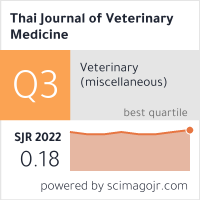A study of the temporal dynamics and human exposure to the Formosan ferret-badger (Melogale moschata subaurantiaca) rabies, 2013 to 2019, Taiwan
Keywords:
Formosan ferret-badger rabies, Taiwan, rabies, wildlife diseases, epidemiologyAbstract
The World Health Organization declared Taiwan rabies-free in 1961. On July 17, 2013, Taiwan confirmed the
detection of rabies virus in wild Formosan ferret-badgers. This study investigated the epidemiology of Formosan ferretbadger rabies from July 2013 to December 2019 on Taiwan Main Island. There were two objectives of this study: 1) to
study the temporal dynamics of the epidemics during this period; 2) to assess the risk of human exposure to ferretbadger rabies. Results indicated that a total of 805 rabies-confirmed ferret-badgers and 9 cases of spillover infection in
non-reservoir hosts. The temporal dynamics showed only the epidemic in Eastern Taiwan exhibited the typical initial
epidemic growth pattern; while the epidemics in Western Taiwan and Southern Taiwan appeared to have subsided to
enzootic levels as of December 2019. As for human exposure to ferret-badger rabies, all cases of human exposure at
home appeared in only one ferret badger and usually occurred in the evening. During the exposures, if a dog were
present, it would usually spot the rabid ferret-badger earlier than the attack of the rabid ferret-badger and rush to kill
it. There were 48 cases indoors and 21 cases outdoors of human exposure. The relative risk (RR) for human exposure
to rabid ferret-badgers without dogs around was 4.73 times that with dogs around indoors (n=214; p < 0.0001). The risk
for human exposure to rabid ferret-badgers without dogs around was 12.63 times that with dogs around outdoors
(n=62; p < 0.05). In conclusion, the study showed that keeping dogs could protect people from suddenly unprovoked
attacks by rabid ferret-badgers. The distribution of epidemic cases indicated that ferret-badger rabies was still
sequestered to the mountainous regions. Dogs and cats should be vaccinated to establish an immunological barrier to
stop the spread of the disease.






